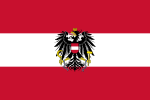آسٽريا جو صدر
آسٽريا جو صدر(انگريزي: President of Austria) آسٽريا جي ريپبلڪ جو رياستي سربراھ آھي.
| صدر آسٽريا
| |
|---|---|
 جھنڊو | |
 نسبتي نشان Executive branch of the Government Presidential Chancellery | |
| تعظيمي لقبَ | Mr. President (ordinary) His Excellency (diplomatic) |
| رهائش | Leopoldine Wing, Hofburg Imperial Palace |
| تجويز ڪندڙ | Political parties or self-nomination |
| مقرر ڪندڙ | Direct popular vote |
| عھدي جي مدت | Six years, renewable once |
| تشڪيل | * Date established: 1 October 1920
|
| اولين حامل | Michael Hainisch |
| پگهار | €349,398 annually |
| ويب سائيٽ | www.bundespraesident.at |
Though theoretically entrusted with great power by the Constitution, in practice the president is largely a ceremonial and symbolic figurehead.
The office of the president was established in 1920 by the newly-crafted Federal Constitutional Law, following the collapse of the Austro-Hungarian Empire and the Habsburg Monarchy in 1918. As head of state, the president succeeded the chair of the Constituent Assembly, the post-monarchic provisional legislature. Originally intended to be chosen directly by the Austrian people through universal suffrage every six years, the president was appointed by the legislative Federal Assembly until 1951, when Theodor Körner became the first popularly-elected president. Since the institution of the popular vote, only nominees of the Social Democratic Party and the People's Party had been appointed to the presidency, until the election of the Green-endorsed incumbent Alexander Van der Bellen in 2016.
The president appoints the chancellor, the vice chancellor, the ministers, the secretaries of state, and the justices of the Supreme Courts[سلجهائپ گھربل]. The president can also remove the chancellor and the Cabinet at any time. Additionally, the president signs bills into law, is empowered to, dis